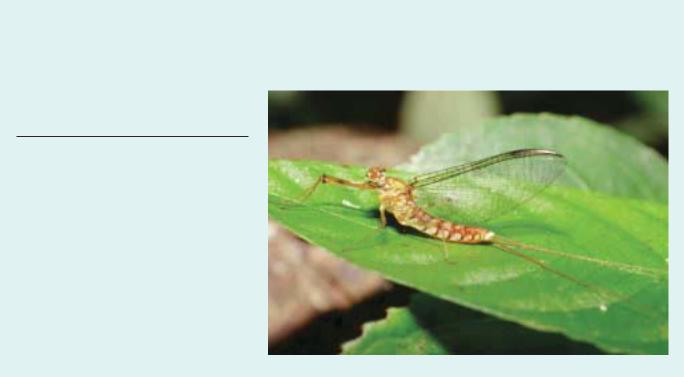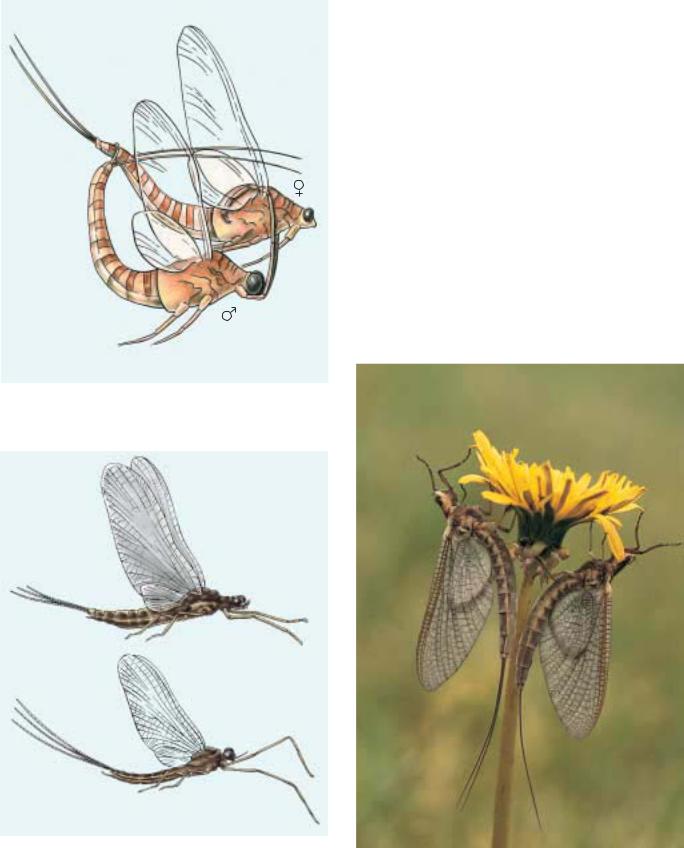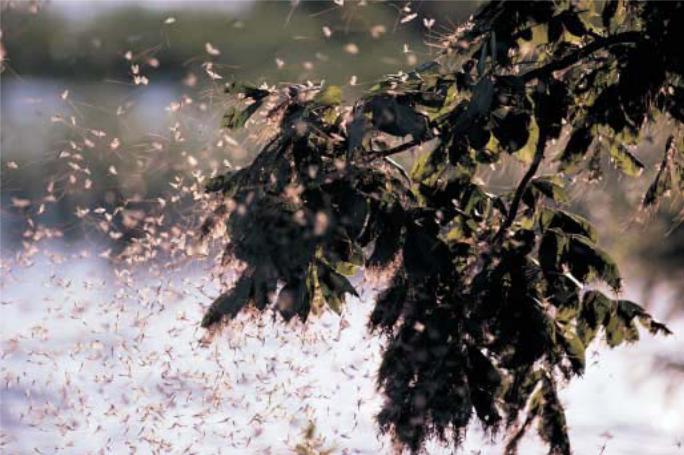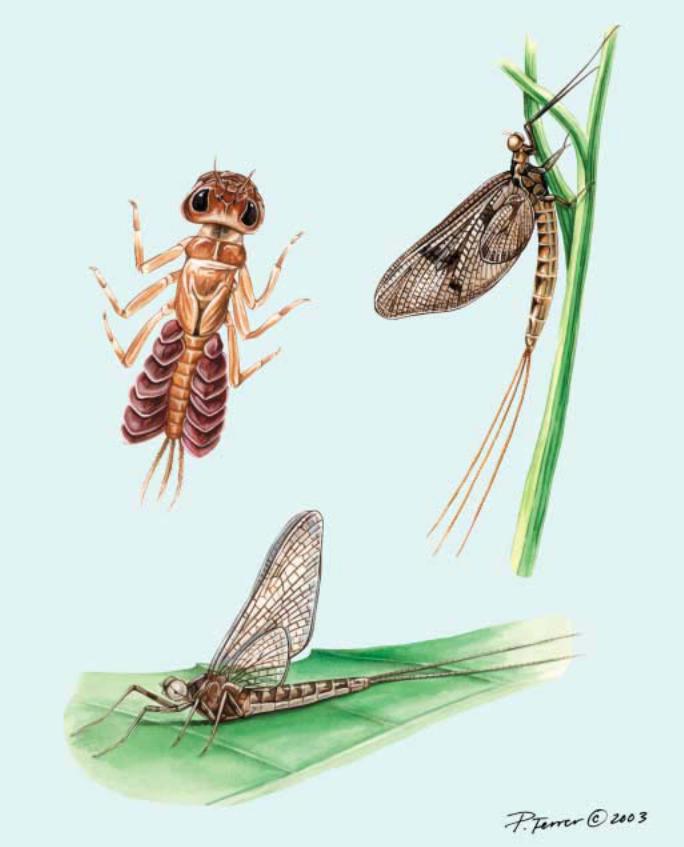
- •Contents
- •Foreword
- •How to use this book
- •Advisory boards
- •Contributing writers
- •Contributing illustrators
- •What is an insect?
- •Evolution and systematics
- •Structure and function
- •Life history and reproduction
- •Ecology
- •Distribution and biogeography
- •Behavior
- •Social insects
- •Insects and humans
- •Conservation
- •Protura
- •Species accounts
- •Collembola
- •Species accounts
- •Diplura
- •Species accounts
- •Microcoryphia
- •Species accounts
- •Thysanura
- •Species accounts
- •Ephemeroptera
- •Species accounts
- •Odonata
- •Species accounts
- •Plecoptera
- •Species accounts
- •Blattodea
- •Species accounts
- •Isoptera
- •Species accounts
- •Mantodea
- •Species accounts
- •Grylloblattodea
- •Species accounts
- •Dermaptera
- •Species accounts
- •Orthoptera
- •Species accounts
- •Mantophasmatodea
- •Phasmida
- •Species accounts
- •Embioptera
- •Species accounts
- •Zoraptera
- •Species accounts
- •Psocoptera
- •Species accounts
- •Phthiraptera
- •Species accounts
- •Hemiptera
- •Species accounts
- •Thysanoptera
- •Species accounts
- •Megaloptera
- •Species accounts
- •Raphidioptera
- •Species accounts
- •Neuroptera
- •Species accounts
- •Coleoptera
- •Species accounts
- •Strepsiptera
- •Species accounts
- •Mecoptera
- •Species accounts
- •Siphonaptera
- •Species accounts
- •Diptera
- •Species accounts
- •Trichoptera
- •Species accounts
- •Lepidoptera
- •Species accounts
- •Hymenoptera
- •Species accounts
- •For further reading
- •Organizations
- •Contributors to the first edition
- •Glossary
- •Insects family list
- •A brief geologic history of animal life
- •Index

●
Ephemeroptera
(Mayflies)
Class Insecta
Order Ephemeroptera
Number of families 37–40
Photo: A giant mayfly sitting on a leaf on a forest trail in Thailand. (Photo by Rosser W. Garrison. Reproduced by permission.)
Evolution and systematics
The scientific name of the order refers to the short life of the adult, or winged state. The English common name is associated with the month of May, when adults emerge more frequently in the Northern Hemisphere. The members of this order appear to be the most primitive of the extant flying insects. Fossil representatives that can be assigned to Ephemeroptera are known from the Upper Carboniferous, with some of the extinct groups (Bojophlebia prokopi) reaching gigantic sizes (a wingspan of up to 18 in, or 45 cm). Permian species had aquatic larvae, but unlike extant species, adults had functional mouthparts and pairs of wings of almost equal size.
The relationships of Ephemeroptera with other insect orders are still the subject of controversy. While some authors maintain that this order is related more closely to the dragonflies and damselflies (Odonata), forming the group Palaeoptera, others consider the Ephemeroptera basal to the other winged insect orders. The higher classification of the order is also questionable, with differing classifications at the suborder and superfamily levels. There are about 40 recognized fossil and extant families.
Physical characteristics
Body size ranges from very small (0.04 in, or 1 mm) to large (3.2 in, or 80 mm). Adults are of varying colors—white, yellow, pink, or black—generally with hyaline wings. Males generally are svelte, with the abdomen almost completely filled with air. The forelegs are always functional and very long. In females the body is more robust and stout, with the abdomen and part of the thorax filled with eggs. The hind wings can be absent, but when they are present, they always are smaller than the forewings. In some groups (e.g., Poly-
mitarcyidae) the adult legs are nonfunctional with the exception of the first pair on the male; some leg segments may even be lost (e.g., the American genus Campsurus). The caudal filaments (two or three) are always present and are longer in males. While the overall appearance of the adults is remarkably standard, the larvae possess a wide variety of body shapes, ranging from depressed and shield-like among the swirl current dwellers to long and cylindrical among secluded tunnel inhabitants or spindle-like in the free-swimming forms.
A unique characteristic of Ephemeroptera is the presence of an extra winged stage, called the “subimago.” It is similar to the adult stage, or imago, but the coloration is duller, the body more robust, and the wings usually smoky. This extra stage allows for the dramatic elongation of some parts of the body (male legs and genitalia). They are covered with waterrepellent microhairs, which are important in allowing them to pass from the aquatic medium to the air.
Distribution
Cosmopolitan, except Antarctica, the extreme Arctic, and a few small oceanic islands.
Habitat
The larvae inhabit a wide variety of bodies of water, from swiftly running streams high in the mountains to lowland rivers, ponds, and lakes. Many live under rocks or debris, whereas others burrow in living or decaying plant tissues or the clay bottoms of rivers and lakes. Others swim freely in small ponds, and a few live in the film formed by water seepage. While most species are sensitive to pollution, some can tolerate a certain level of contamination of their habitat. For example, some species of the genera Callibaetis and Baetis
Grzimek’s Animal Life Encyclopedia |
125 |

Order: Ephemeroptera
Copulating pair of Rhithrogena semicolorata. (Illustration by Patricia Ferrer)
A
B
Difference between subimago (A) and imago (B). The subimago has duller coloration, a more robust body, and shorter legs and caudal filaments. (Illustration by Patricia Ferrer)
Vol. 3: Insects
(Baetidae) can tolerate high contents of organic matter and relatively low oxygen, while some species of Caenis (Caenidae) can stand certain high levels of suspended sediments. The adults, which normally are weak fliers, stay close to the water, where immature insects live.
Behavior
Most larvae hide during the day to avoid predation, but some swim freely at this time. Some species are gregarious, especially those that live in restricted patchy environments, but no social structure is known. Adults spend most of the day resting in the shade of vegetation close to the water, until swarming time, at which point they fly actively.
Feeding ecology and diet
Mayflies feed only as larvae; mouthparts and the digestive system are atrophied in adults. Most larvae are detritivores or herbivores, but a few are predators. Some modifications of mouthparts or forelegs or both occur in some species of Oligoneuriidae and Polymitarcyidae that filter food. Larvae
A pair of mayflies (Ephemera danica) on a dandelion stem. (Photo by John Shaw. Bruce Coleman, Inc. Reproduced by permission.)
126 |
Grzimek’s Animal Life Encyclopedia |

Vol. 3: Insects |
Order: Ephemeroptera |
Mayflies (Hexagenia sp.) emerge from water and swarm to tree branches. (Photo by ©James H. Robinson/Photo Researchers, Inc. Reproduced by permission.)
of species living in tunnels filter food from the water current that is produced by the active movement of the abdominal gills. Mayflies are important components of the food chain; fish, birds, and invertebrates eat both adults and larvae. These insects are popular with fly fishermen, who tie flies to imitate certain species of larvae and adults and time their fishing to emergence patterns for best results.
Conservation status
Some species have a restricted distribution and strict ecological tolerance and are more endangered than are the widely distributed species. The main reasons for population decline are habitat degradation by pollution, deforestation of river margins, dam construction, and introduction of exotic fish. Two mayfly species are listed as Extinct and one as Vulnerable by the IUCN.
Reproductive biology
The mating flight, or “swarm,” of the male imagoes is one of the distinctive features of the order. The swarm time, location, flight pattern, and number of individuals participating are specific to each species. Some swarms are composed of a few males and others by hundreds of thousands. The female flies above the swarm and is taken by a male from below, using his long forelegs. Shortly after copulation the female deposits eggs in the water. The female can carry 100 to 12,000 eggs. Egg development ranges from one week to a year and the larval period from three weeks to three years.
Significance to humans
The larvae, as primary consumers, filter and remove large amounts of nutrients from the water and are important as food for other aquatic organisms. Owing to their sensitivity to contaminants, mayflies are used as bioindicators of water quality. The winged stage facilitates nutrient and energy exportation from aquatic to terrestrial ecosystems. A few larvae burrow in wooden structures, and when some species that form massive swarms are attracted to town lights, they cause allergy-related problems for some people.
Grzimek’s Animal Life Encyclopedia |
127 |

2
1
3
1. Chiloporter eatoni nymph stage; 2. Ephemera vulgata; 3. Stenonema vicarium. (Illustration by Patricia Ferrer)
128 |
Grzimek’s Animal Life Encyclopedia |
